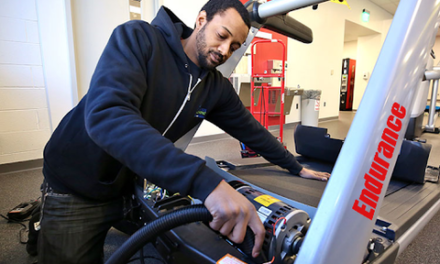Are you considering purchasing a treadmill for your home gym? If so, you may be wondering just how important the weight capacity of a treadmill is. Well, let me tell you, it’s crucial! The weight capacity of a treadmill not only affects the machine’s performance and durability but also your safety during workouts. In this article, we will explore why the weight capacity of a treadmill is a crucial factor to consider when making your buying decision. So, keep on reading to discover how important it is to choose a treadmill with the right weight capacity for your needs.

This image is property of pixabay.com.
Understanding Treadmill Weight Capacity
Definition
Treadmill weight capacity refers to the maximum weight that a treadmill can safely support during use. It is an important specification to consider when choosing a treadmill, as exceeding its weight capacity can lead to equipment malfunctions and safety hazards.
Importance
The weight capacity of a treadmill is crucial for ensuring the safety and effectiveness of your workouts. It determines the maximum weight that the treadmill can handle without straining its components or compromising its performance. Understanding and adhering to the weight capacity is essential to avoid potential damage to the treadmill, prevent accidents and injuries, and ensure a comfortable and efficient workout experience.
Factors Influencing Weight Capacity
Frame Strength
The frame of a treadmill is its primary support structure, and its strength is a significant factor in determining the weight capacity of the machine. A robust and durable frame will be able to withstand higher weights without compromising stability and performance. In general, treadmills with heavier and sturdier frames tend to have higher weight capacities.
Belt Durability
The belt of a treadmill is another critical component that influences its weight capacity. A high-quality and heavy-duty belt is designed to withstand the impact and friction caused by running or walking. Treadmills with stronger and more durable belts can handle higher weights more effectively.
Motor Power
The power of the treadmill’s motor plays a role in determining its weight capacity. A more powerful motor is capable of driving the belt, supporting the user’s weight, and maintaining consistent speed even under heavy loads. Treadmills with stronger motors generally have higher weight capacities.
Impact Absorption
The ability of a treadmill to absorb the impact of each step is crucial, especially for heavier users. Efficient and effective impact absorption minimizes the stress on the treadmill’s components and extends its lifespan. Treadmills with advanced cushioning systems or shock absorption technology can handle higher weights more efficiently.
Safety Features
Certain safety features, such as automatic shut-off mechanisms, emergency stop buttons, and sturdy handrails, can enhance the weight capacity of a treadmill. These safety measures ensure that the treadmill can handle unexpected movements or heavy loads without compromising user safety. Treadmills equipped with reliable safety features provide peace of mind, especially for users close to or exceeding the weight capacity.
Benefits of Choosing the Right Weight Capacity
Avoiding Damage to the Treadmill
By selecting a treadmill with an appropriate weight capacity, you can avoid putting excessive strain on its components. Exceeding the weight capacity can lead to premature wear and tear, resulting in costly repairs or the need for a new treadmill. Choosing the right weight capacity ensures your treadmill remains in optimal condition for an extended period.
Preventing Accidents and Injuries
Using a treadmill that is overloaded or beyond its weight capacity puts users at risk of accidents and injuries. The machine may become unstable, causing it to wobble or even collapse during use. By adhering to the weight capacity, you can minimize the risk of accidents and create a safe workout environment.
Comfortable and Efficient Workout Experience
When using a treadmill with the appropriate weight capacity, users can experience a more comfortable and effective workout. Treadmills that are not overloaded can provide a smoother and more stable running or walking surface, allowing for better stride control and reduced impact on joints. Choosing the right weight capacity ensures a pleasurable and efficient workout experience.
Consequences of Ignoring Weight Capacity
Premature Wear and Tear
Ignoring the weight capacity of a treadmill can lead to premature wear and tear of its components. Excessive strain on the frame, belt, and motor can cause them to deteriorate at a faster rate than intended. This can result in costly repairs or the need for a new treadmill altogether.
Safety Hazards
Exceeding the weight capacity of a treadmill poses significant safety hazards. Overloaded treadmills can become unstable, leading to wobbling or collapsing during use. This can cause users to lose balance, resulting in falls and injuries. Ignoring weight capacity can put both users and their surrounding environment at risk.
Ineffective Workouts
When a treadmill is overloaded, it may not be able to maintain consistent speed or provide sufficient cushioning. This can result in an ineffective workout, making it difficult for users to achieve their fitness goals. By ignoring weight capacity, users may compromise the effectiveness of their workouts.
Invalidating Warranty
Using a treadmill beyond its weight capacity can void the manufacturer’s warranty. Most warranties explicitly state that the treadmill must be used within its weight limitations. Ignoring this requirement can result in the loss of warranty coverage, leaving users responsible for any repairs or replacements.

This image is property of pixabay.com.
Matching Weight Capacity to User’s Weight
Determining Appropriate Weight Capacity
To determine the appropriate weight capacity, users should take their body weight into account. It is crucial to select a treadmill with a weight capacity that exceeds the user’s weight to ensure safety and optimal performance. It is generally recommended to choose a treadmill with a weight capacity that is at least 20% higher than the user’s weight.
Considerations for Overweight Users
For overweight individuals, it is even more important to choose a treadmill with a higher weight capacity. Extra pounds put additional strain on the treadmill, and selecting a model with ample weight capacity can help minimize the risk of damage and safety hazards. It is advisable for overweight users to consult with fitness professionals or their healthcare provider to determine the most suitable weight capacity.
Considerations for Multiple Users
If multiple individuals will be using the treadmill, it is essential to consider the highest weight among the users. The weight capacity should be sufficient to accommodate the heaviest user to ensure the safety and longevity of the equipment.
Reliability and Durability
Longevity of the Treadmill
Choosing a treadmill with an appropriate weight capacity contributes to its longevity. By selecting a treadmill that can handle the user’s weight, the machine is less likely to experience premature wear and tear. This extends the lifespan of the treadmill and reduces the frequency of repairs or replacements.
Sturdiness of the Equipment
Treadmills with higher weight capacities often have sturdier constructions. The frame, belt, and other components are designed to withstand heavy loads, providing stability and reliability. By opting for a treadmill with a higher weight capacity, users can have confidence in the durability and performance of the equipment.

This image is property of pixabay.com.
Choosing the Right Weight Capacity
Assessing User’s Weight
The first step in choosing the right weight capacity is accurately assessing the user’s weight. Users should weigh themselves and ensure they have an accurate measurement to base their decision on.
Future Weight Gain/Loss
Consideration should be given to any potential weight gain or loss in the future. Weight fluctuations can affect the suitability of the current weight capacity of the treadmill. It is advisable to choose a weight capacity that can accommodate potential changes in weight to ensure long-term usability.
Treadmill Usage Frequency
The frequency at which the treadmill will be used is an important factor in determining the appropriate weight capacity. Treadmills that will be utilized more frequently may require higher weight capacities to handle the increased usage and potential wear and tear.
Considerations for Commercial Use
For commercial gym settings, where treadmills are used by numerous individuals throughout the day, it is crucial to select treadmills with high weight capacities. Multiple users with varying weights will make heavy demands on the equipment, necessitating robust machines that can withstand the constant usage.
Manufacturer’s Guidelines
It is always recommended to refer to the manufacturer’s guidelines and specifications when selecting a treadmill. The manufacturer will provide information on weight capacity and make recommendations based on their product’s design and capabilities. Adhering to these guidelines ensures the user is selecting a treadmill that will perform optimally and safely.
Potential Trade-Offs for Higher Weight Capacity
Cost
Treadmills with higher weight capacities often come with a higher price tag. The increased materials and construction necessary to accommodate heavier weights can contribute to a higher overall cost. Users should consider their budget and prioritize their needs when weighing the cost-benefit of higher weight capacity.
Size and Portability
Treadmills with higher weight capacities may be physically larger and heavier. This can impact the available space for the equipment and its ease of portability. Users should evaluate their available space and mobility requirements when considering a treadmill with a higher weight capacity.
Extra Features
Some treadmills with higher weight capacities may offer additional features and functionalities. These features, such as touchscreen displays, workout programs, heart rate monitors, and incline/decline options, can enhance the overall exercise experience but may come at an additional cost. Users should assess their preferences and requirements in terms of extra features before making a final decision.
Finding Reliable Weight Capacity Information
Manufacturer’s Specifications
The manufacturer’s specifications and product descriptions are primary sources of accurate weight capacity information. These details can be found on the manufacturer’s website, in product manuals, or on the treadmill’s packaging. Utilizing official information ensures accurate and reliable weight capacity information.
Customer Reviews and Feedback
Checking customer reviews and feedback can provide valuable insights into the reliability and performance of a treadmill’s weight capacity. Users who weigh close to or exceed the weight capacity may share their experiences and observations regarding the equipment’s suitability. While individual experiences may vary, reading multiple reviews can help establish a more comprehensive understanding.
Expert Opinions
Fitness professionals and experts in the field of exercise equipment can provide valuable guidance when it comes to selecting a treadmill with the right weight capacity. Their experience and expertise can help users make informed decisions based on individual needs, goals, and constraints.
Conclusion
Key Considerations
Understanding and adhering to the weight capacity of a treadmill is crucial for safety, longevity, and optimal performance. Key considerations include assessing the user’s weight accurately, selecting a weight capacity that exceeds the user’s weight, taking into account potential future weight gain or loss, considering the treadmill’s usage frequency, and reviewing the manufacturer’s guidelines.
Importance of Weight Capacity
The weight capacity of a treadmill plays a significant role in the overall exercise experience and safety. By choosing the right weight capacity, users can avoid damage to the equipment, prevent accidents and injuries, and ensure effective workouts. It is essential to prioritize weight capacity when selecting a treadmill to optimize the durability, reliability, and performance of the equipment.





